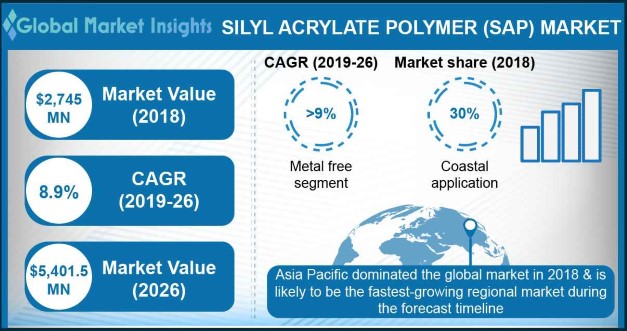Home > Chemicals & Materials > Polymers > Industrial Polymers > Silyl Acrylate Polymer (SAP) Market
Silyl Acrylate Polymer (SAP) Market Size
- Report ID: GMI1315
- Published Date: Mar 2020
- Report Format: PDF
Silyl Acrylate Polymer Market Size
Silyl Acrylate Polymer Market size was valued over USD 2.7 billion in 2018 and is estimated to exhibit CAGR around 9% from 2019 to 2026. Growing need for TBT-free and low emission antifouling coatings will augment the growth of global market.
Proliferating shipbuilding industry in the Asia Pacific region is the prime factor augmenting the global market growth. Silyl acrylate polymer (SAP) is widely used as an antifouling agent owing to its superior adherence to hulls of the ships and prevention of accumulation of biological species. It is mainly led by China, South Korea, and Japan which accounted for more than 90% of the global shipbuilding industry, in 2018.
In 2018, China dominated the global shipbuilding sector with over 40% market share, followed by South Korea with a robust share of almost 25%, and Japan above 22%. Moreover, China is a prominent country in drydocking activities in addition to its new shipbuilding activities, which will further bolster the silyl acrylate polymer consumption in repair & maintenance and newbuilding sectors.
| Report Attribute | Details |
|---|---|
| Base Year: | 2018 |
| Silyl Acrylate Polymer Market Size in 2018: | 2,746.0 Million (USD) |
| Forecast Period: | 2019 to 2026 |
| Forecast Period 2019 to 2026 CAGR: | 8.9% |
| 2026 Value Projection: | 5,401.5 Million (USD) |
| Historical Data for: | 2016 to 2017 |
| No. of Pages: | 170 |
| Tables, Charts & Figures: | 259 |
| Segments covered: | Product type, Sector, Application, Region |
| Growth Drivers: |
|
| Pitfalls & Challenges: |
|
Additionally, surging maritime trade in Asia Pacific countries such as India and favorable government initiatives will offer ample growth opportunities in ship maintenance & repair services.
Favorable geographic locations for sea trade, presence of numerous shipbuilding companies, and availability of low-cost skilled labor have a positive influence on the shipping industry in Asia Pacific. These factors propel the silyl acrylate polymer market demand in the production of antifouling coatings.
Moreover, Southeast Asian countries such as Philippines, Vietnam, Indonesia, and Singapore offer lucrative opportunities to the silyl acrylate polymer market manufacturers. This is because these countries are equipped with fast-developing ports and docks with low-cost labor and presence of valuable trade routes. Furthermore, Singapore has garnered the leading position in trading of ship parts and ship repair activities and is likely to surpass shipbuilding leaders in the coming years.
There are growing concerns for TBT-free and ecofriendly antifouling paints which provides excellent antifouling performance and substantially reduces fuel consumption. Silyl acrylate polymer has a low erosion rate with stable performance over longer period, thus, it is considered as a viable option among other antifoulants. Moreover, rising government initiatives and growing drydocking activities further drive the shipbuilding business in the Asia Pacific region.
Silyl acrylate polymer is an antifouling coating which comes under self-polishing copolymer (SPC). It is produced by various acrylic monomers, silyl ester, silanes, and acrylates. The product is incorporated with various biocides such as cuprous oxide, copper pyrithione, zinc oxide, and zinc pyrithione to prevent the build-up of algae, barnacles, slime, and other invasive species. It possesses low VOC levels than metal acrylates.
Silyl Acrylate Polymer has a low erosion rate and exhibits controlled release of biocides in sea water, which creates a smooth surface on the hull and reduces the adherence. It exhibits excellent antifouling performance coupled with self-polishing properties. Growing R&D investments and product innovation are enhancing the product characteristics to meet the industry antifouling needs will drive the growth of silyl acrylate polymer market.
Key raw materials such as acrylic monomers are crude oil derivatives. Also, copper is widely used in the production of biocides which are incorporated in silyl acrylate polymer. However, fluctuating prices of crude oil and copper are expected to impact the global silyl acrylate polymer market growth in the following years. Moreover, availability of cost-effective substitutes such as foul release agents and rosin-based coatings is likely to restrain the SAP consumption during the review period.

